IN THIS ISSUE
- Adding conservation lands
- Pocket gophers up close
- Winterizing yards for wildlife
- Watch: Video of aid to injured whale calf
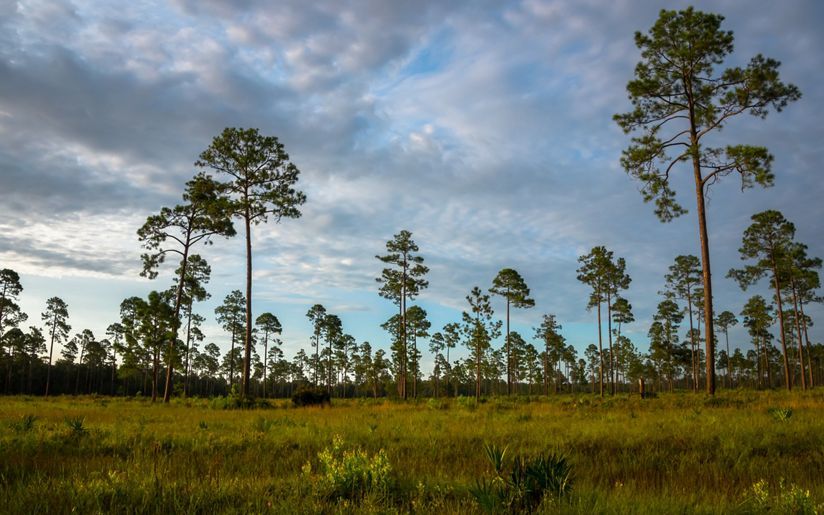 Cabin Bluff (Wade Harrison/The Nature Conservancy)
The acreage in south Georgia earmarked for wildlife and recreation is on the rise.
Canoochee Sandhills Wildlife Management Area held its grand opening this month, celebrated by partners who helped acquire the 6,300-plus acres in Bulloch and Bryan counties. Canoochee harbors prime hunting, rare species such as gopher tortoises and the promise of restoring longleaf pine habitats.
Also, this week the Georgia Outdoor Stewardship Program announced its inaugural grants for conservation and outdoor recreation projects. They include:
- $3.5 million toward DNR acquiring more than 4,000 acres in Camden County. The proposed purchase, called phase 1 of Ceylon, part of nearly 16,000 acres The Conservation Fund and Open Space Institute bought last year, is planned as a WMA. Ceylon is one of the largest undeveloped shoreline tracts on the southeast Atlantic coast.
- $2.5 million aimed at conserving 11,175 acres at Cabin Bluff, also in Camden County. Almost 8,000 acres are targeted for acquisition as a WMA; 3,217 acres would be protected by conservation easement.
Read more on the Georgia Outdoor Stewardship grants, totaling almost $20 million and involving projects ranging from Johns Creek to Decatur County.
Top
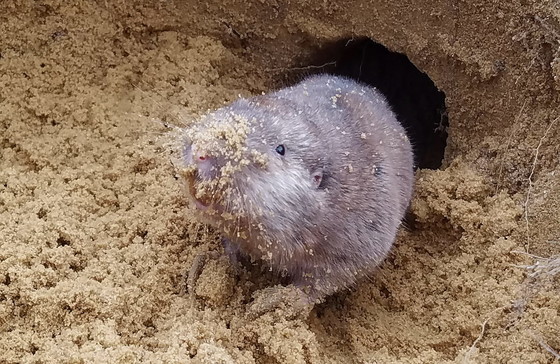 Southeastern pocket gopher (J.T. Pynne)
By J.T. PYNNE
The southern half of Georgia is home to a secretive and sometimes angry rodent.
Southeastern pocket gophers, also called sandy-mounders, live almost entirely underground. They are expert diggers (watch), creating intricate tunnel systems below the surface and obvious mounds of soil on it.
It’s a life they are highly adapted to, with small ears and eyes, lips that close behind their teeth to prevent soil from entering their mouth, and large digging claws.
They are called pocket gophers for the external, fur-lined cheek pouches they use like pockets to transport roots to food caches.
But despite the cute name and small size, pocket gophers can be quite aggressive when uncovered!
Learn about these feisty rodents and why they’re in decline in this blog post.
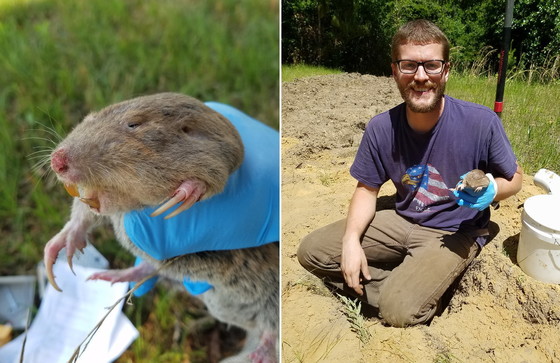 Researcher J.T. Pynne with gophers in hand
SANDY-MOUNDER SIGHTINGS
Report observations of pocket gophers on iNaturalist.
J.T. Pynne is studying pocket gophers as a doctoral student at UGA’s Warnell School of Forestry and Natural Resources.
Top
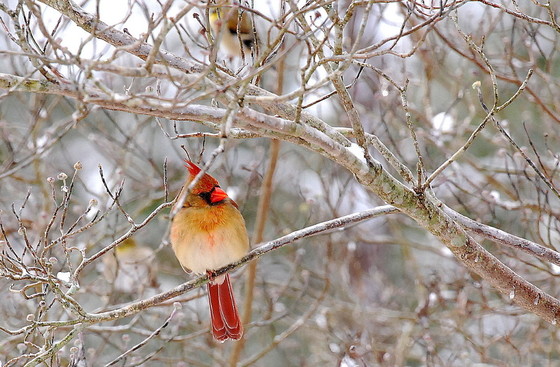 Female northern cardinal (Terry W. Johnson)
By TERRY W. JOHNSON
Despite the imagery and songs about winter being a magical wonderland, our coldest season is far from idyllic for backyard wildlife.
In fact, many birds and other wild animals face a daily struggle to survive in winter.
It's also ironic that winter is when scores of wildlife – especially birds – make our yards their home. More species of seed-eating birds, from fox sparrows to dark-eyed juncos, are inhabiting our yards now than at any other time of the year.
To help address the challenges these animals face, DNR and The Garden Club of Georgia have created a component to their joint Community Wildlife Project called Creating a Winter Wildlife Wonderland. This addition to an initiative that has promoted wildlife conservation at home for more than two decades focuses on making sure yards have appropriate wildlife cover, food and water for the season.
Read the rest of Terry’s column about wildlife in winter and how you can help …
Terry W. Johnson is a retired DNR program manager and executive director of TERN, the Wildlife Conservation Section’s friends group. Check out past columns, Terry's Backyard Wildlife Connection blog and his book “A Journey of Discovery: Monroe County Outdoors.” (Permission is required to reprint his column.)
Top
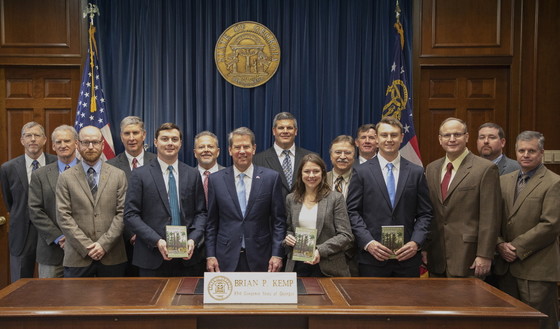 Forestry for Wildlife Partners with Gov. Kemp and DNR leaders
A Georgia landowner program that has helped improve wildlife habitat and provide outdoor recreation on thousands of acres has been opened to more landowners.
Started in 1996, DNR's Forestry for Wildlife Partnership is a voluntary and participant-driven effort that encourages wildlife conservation on large private forestlands and provides public access for hunting, fishing, wildlife viewing, hiking and camping.
Yet in response to trends in land ownership and forestry standards, the partnership made two key changes this year:
- Lowering the minimum acreage from 20,000 to 10,000 acres.
- Linking partner status to landowners completing projects that meet conservation goals in Georgia’s State Wildlife Action Plan or Bobwhite Quail Initiative.
Learn more about the partnership and changes online or from DNR’s Steve Raper.
LEADING PARTNERS
Gov. Brian Kemp and DNR recently announced this year’s Forestry for Wildlife Partners. Weyerhaeuser, CatchMark Timber Trust and Georgia Power were recognized for stewardship and land management practices benefiting wildlife and outdoor enthusiasts on more than 1 million acres.
In the next Georgia Wild: Teaming up to restore rare birds at Sprewell Bluff.
Top
 Eastern diamondback rattlesnake (Mark Krist)
Snakes alive, plus wildlife programs, vintage cars and archery shoot-offs, will pack the 53rd annual Claxton Rattlesnake and Wildlife Festival near Hagan March 14 and 15. Meanwhile, another former rattler roundup, Fitzgerald’s Wild Chicken Festival, will draw a crowd to that south Georgia city March 20-21.
Plant restoration and preservation will take center stage at the second Southeastern Partners in Plant Conservation Symposium and Workshop Monday through Friday at Atlanta Botanical Garden. As during the 2016 conference, scientists and land managers from botanical gardens, universities, agencies and others will explore building capacity and networks to conserve plants region-wide.
The bald eagle nest live-streamed at Berry College will not have eaglets this year. One egg has cracked, and been disposed of by the adults, and the other egg is outside the viability window and will not hatch, either because it wasn’t fertile or viable.
The news is brighter for The Landings nest cam near Savannah. It looks like ospreys have adopted a replacement nest built by cam operators after the dead tree holding the original nest had to be cut down.
Top
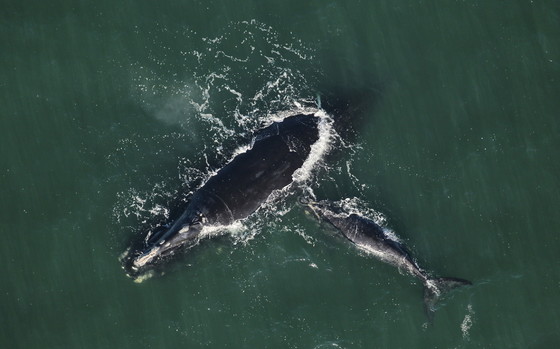 Right whale No. 2223 and calf (Clearwater Marine Aquarium/NOAA permit 20556-01)
This winter’s count of North Atlantic right whale calves in the Southeast has reached 10, more than in the last three years but still shy of the 15-20 needed annually to sustain the imperiled whales. A newborn calf injured by a boat strike has not been seen since January, when scientists hoping to stave off infection administered antibiotics to the calf by crossbow (video). Right whale surveys by plane and boat off Georgia's coast will continue through March.
Canada announced new measures Thursday to help protect right whales in Canadian waters, where 29 have died from boat strikes or entanglement in commercial fishing gear since 2017. According to a Canadian Broadcasting Co. report, the changes include temporary fishing closures in areas where the whales gather, extending boat speed limits set last year and adding limits in other areas.
What can you do for right whales? Give them space (the law requires staying at least 500 yards away), report sightings (call DNR at 800-272-8363, NOAA at 877-942-5343 or radio the Coast Guard on marine VHF channel 16) and learn more, such as about the SAVE Right Whales Act (S. 2453 and H.R. 1568).
Top
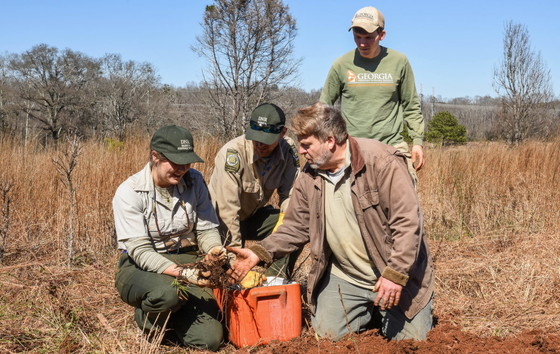 Dwarf sumac match-making at Panola Mountain (Hal Massie/DNR)
On Valentine’s Day, Wildlife Conservation Section’s Dr. Mincy Moffett Jr. and Morgan Bettcher led a Georgia Plant Conservation Alliance workday to move 20 male dwarf sumac plants from Lower Broad River Wildlife Management Area to Panola Mountain State Park near Stockbridge. Befitting the day, the male plants – in the sumac genus, plants are single sex – were added to an introduced population of dwarf sumac females, in hopes the combo will produce viable seed at Panola.
What's not fun about Valentine's Day? Balloons that end up in the wild. On a recent trip off Georgia's coast, a DNR right whale crew fished five balloons out of the water. (During last year's sea turtle nesting season, turtle techs picked up nearly 250 on Ossabaw Island. Sea turtles will eat balloons, mistaking them for food.)
Getting children and teens involved in birdwatching is easy in Georgia. Coming up April 24-25 is DNR’s popular, fun and free Youth Birding Competition, which includes an art contest (deadlines and details). Registration is also open for the agency’s acclaimed Camp TALON – Teens Adventures Learning Ornithology and Nature – June 6-11 on the coast (overview and video).
While excessive rain has put a damper on prescribed fire plans statewide, wildland firefighter academies near St. Marys and last month at Hard Labor Creek State Park near Rutledge trained more than 70 people in prescribed fire. Meanwhile, in what has become an annual ceremony for Georgia, the first week of February was proclaimed Prescribed Fire Awareness Week.
Top
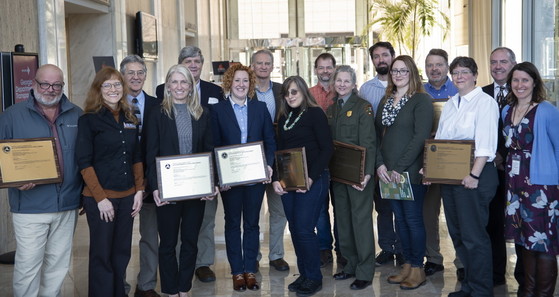 Georgia Plant Conservation Alliance members mark Federal Highway Administration award
Names in the news: In January, Dan Hinton of the Federal Highway Administration presented plaques to representatives of the Georgia Department of Transportation and fellow Georgia Plant Conservation Alliance members. The local recognition followed DOT’s selection as a 2019 Environmental Excellence Award recipient for work with the GPCA to restore habitats, safeguard rare plants and address invasive species. DNR’s Jerome Hay has been named the National Wild Turkey Federation’s Joe Kurz Wildlife Manager of the Year for 2019. Hay, a wildlife technician, revived the prescribed fire regime on Clarks Hill WMA, increased wildlife openings by more than 100 acres and helped improve access to the WMA.
UPCOMING
March 2-6 – Southeastern Partners in Plant Conservation symposium and workshop, Southeastern Center for Conservation, Atlanta Botanical Garden, Atlanta
March 6 – Green Living: Planning for Rainy Days, UGA Marine Extension and Georgia Sea Grant, DNR Coastal Resources Division, Brunswick
March 6-8 – Environmental Education Alliance of Georgia annual conference, Villas by the Sea, Jekyll Island
March 7 – Choosing to Lead conference, One Hundred Miles, Jekyll Island Convention Center
March 14-15 – Claxton Rattlesnake and Wildlife Festival, Hagan
March 20-21 – Fitzgerald Wild Chicken Festival, Fitzgerald
April 24-25 – DNR Youth Birding Competition, awards banquet, including T-shirt Art Contest April 25 at Charlie Elliott Wildlife Center, Mansfield
For more: DNR Wildlife Resources Division events calendar
WHAT YOU MISSED ...
In the previous Georgia Wild:
- Multimedia story of restoring rare birds
- Missing Punctuation: tale of a lost whale
- Where ruby-throated hummers winter
Top
"Taking a tour of the Ceylon tract in Camden," The Brunswick News
Right whales: "As whales slide toward extinction, a desperate search for hope" (Boston Globe); "Why more have been spotted this year" (Canadian Broadcasting Corp.); "NOAA tracks whales by sound" (The Ellsworth American, Maine)
"Learning to love hairy rattleweed," U.S. Fish and Wildlife Service
"Invasive species pose risk to natural environments," The Brunswick News
"Florida may ban sale, ownership of tegus, green iguanas," Gainesville (Fla.) Sun
"Prairie flower (purple coneflower) that flourishes with fire," The New York Times
"DNR announces Forestry for Wildlife Partners, changes," Coastal Courier. Also: The Albany Herald
"UGA joins partnership to combat feral swine," UGA Columns
"Canoochee Sandhills WMA opens," The Statesboro Herald
"Working to restore American chestnut," The Atlanta Journal-Constitution
"Sandhill crane migration on view in Ga. farmland," Georgia Public Broadcasting
"Conservation teacher of year takes learning outside," The Statesboro Herald
"Program stresses hunting for food, health benefits," Fish and Wildlife Service
"Scientists: bumblebees dying across North America, Europe as climate warms," The Washington Post
Top
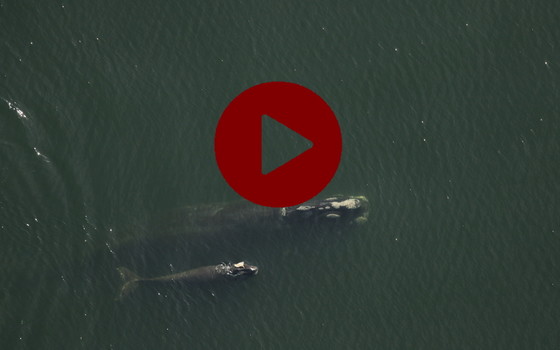 VIDEO & AUDIO
Administering antibiotics to injured right whale calf, and the mother (no. 2360, "Derecha") and calf afterward, DNR, taken under NMFS ESA permit 1886-04
DNR's Emily Ferrall on surveying culverts for bats, Wildlife Resources Division
"Piedmont prairies" (history and restoration in Carolinas, Georgia), Piedmont Prairie Partnership (extended version)
(audio) "Why freshwater mussels are dying," National Public Radio
Loggerhead sea turtle 15 miles off Cumberland Island this month, DNR
Diamorpha blooming on Panola Mountain, Panola Mountain State Park
Top
 Heavyweight lake sturgeon sampled on the Coosa (DNR)
This 19-pound lake sturgeon caught during DNR sampling on the Etowah River last month is the largest documented since the agency begin reintroducing the species to northwest Georgia’s Coosa River system in 1992. UGA researchers actually netted this fish in 2002: It weighed 2 pounds then. Lake sturgeon can live longer than 150 years and top 200 pounds. While fish this size spend most of their time in the deep waters of the Coosa and Lake Weiss, at this time of year some swim into major tributaries in preparation for spawning. Lake sturgeon are protected. Anglers who catch one should release it and report the catch to DNR’s Fisheries Management Section, (706) 295-6102 in Armuchee. Related news: WABE-FM 90.1 (Atlanta); Rome News-Tribune.
CREDIT
Masthead: southeastern pocket gopher (J.T. Pynne)
Top
|